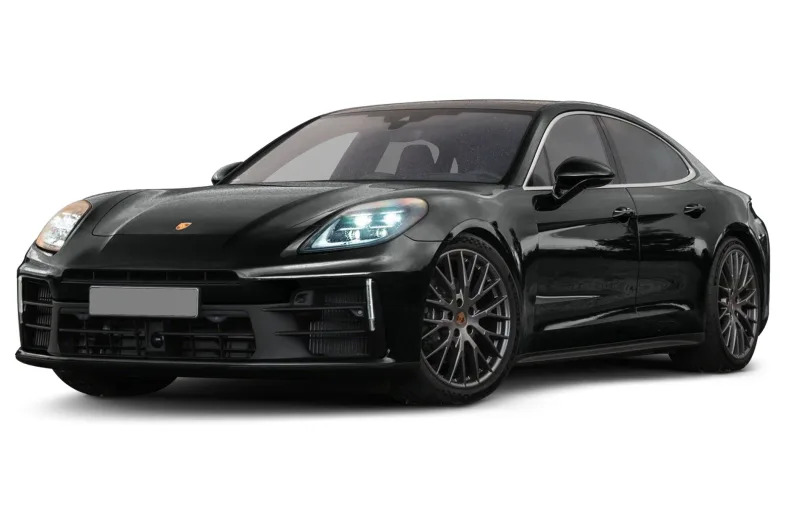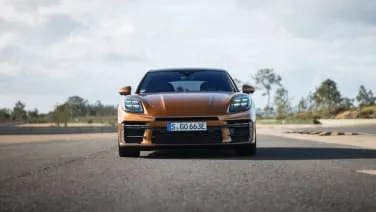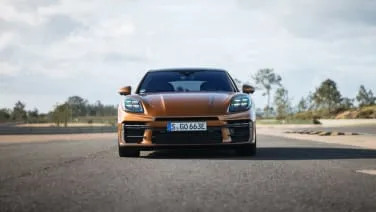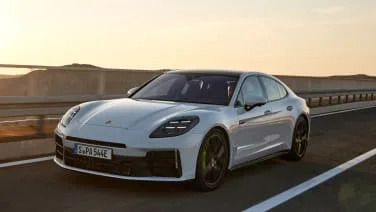Base 4dr Rear-Wheel Drive Hatchback
2024 Porsche Panamera
SEVILLE, Spain – The Panamera has been called many things. To its stewards, it is the Porsche of luxury sedans. To detractors, it’s yet another symbol of the once-great sports car builder’s diluted modern mission. To its engineers, it’s a chance to prove that the Porsche emblem represents excellence in any context, and to do so, they’re willing to do just about anything short of reinventing the wheel. At this rate, humankind’s greatest mobility epiphany may be in jeopardy too, because the 2024 Porsche Panamera doesn’t seem to roll at all. While 2024 represents only a heavy revision of the Panamera’s fundamental platform, it’s also a culmination of a generation’s worth of engineering lessons and technological advancement at a time when electrification is doling out large helpings of both at a breakneck pace. But the 2024 Porsche Panamera isn’t merely a technological tour-de-force. Its engineers weren’t keen to discuss ADAS or the future of self-driving. The Panamera may be a luxury conveyance, but it’s still engineered to be best appreciated from behind the wheel, no matter how enticing the upholstery on the rear split-bucket bench may be. Houndstooth interior or not, the Panamera is not a carpet in the literal sense, but its suspension is indeed magical and the specs bear out the airborne metaphor. It’ll do 0-to-60 in about 3 seconds on the way to a top speed north of 195 mph; that’s flying, certainly. But lithe aerialist, the Panamera is not. Its wide fenders may be designed to mimic the 911’s, but with 670 horsepower and 685 pound-feet of torque, Panamera Turbo E-Hybrid might be a bit more Höllenkatze than Carrera. Those figures may not seem far off from the last gen’s, but remember, this isn’t a clean-sheet redesign. The base and E-Hybrid models are still built around a twin-turbo V6, while the Turbo E-Hybrid utilizes a V8 alongside its hybrid components. The V8’s turbos are single-scroll units now rather than twins, and the PDK now has a motor inside its housing, but the general layout of things hasn’t changed all that much. The real story here is Porsche’s new suspension — the rare bit of wizardry that actually makes the complexity of an adaptive suspension seem worthwhile. We’re talking standard dual-chamber air suspension with the option to upgrade to the Turbo E-Hybrid and its Active Ride, which ventures into no-anti-roll-bars levels of silliness. Anti-roll bars — aka stabilizer bars, sway bars, or “that stupid thing I have to drop the cradle to install” — create a physical link between the opposing corners of a suspension. They reduce body roll by tying the motions of the two corners together. The stiffer the anti-roll bar, the less independently (or the more like a solid axle) your suspension will behave. In other words, anti-roll bars inherently restrict the very advantages that make independent suspension designs worthwhile in the first place. But without anti-roll bars (or an equivalent stand-in), you end up with a smooth but floaty — and decidedly …
Full Review
SEVILLE, Spain – The Panamera has been called many things. To its stewards, it is the Porsche of luxury sedans. To detractors, it’s yet another symbol of the once-great sports car builder’s diluted modern mission. To its engineers, it’s a chance to prove that the Porsche emblem represents excellence in any context, and to do so, they’re willing to do just about anything short of reinventing the wheel. At this rate, humankind’s greatest mobility epiphany may be in jeopardy too, because the 2024 Porsche Panamera doesn’t seem to roll at all. While 2024 represents only a heavy revision of the Panamera’s fundamental platform, it’s also a culmination of a generation’s worth of engineering lessons and technological advancement at a time when electrification is doling out large helpings of both at a breakneck pace. But the 2024 Porsche Panamera isn’t merely a technological tour-de-force. Its engineers weren’t keen to discuss ADAS or the future of self-driving. The Panamera may be a luxury conveyance, but it’s still engineered to be best appreciated from behind the wheel, no matter how enticing the upholstery on the rear split-bucket bench may be. Houndstooth interior or not, the Panamera is not a carpet in the literal sense, but its suspension is indeed magical and the specs bear out the airborne metaphor. It’ll do 0-to-60 in about 3 seconds on the way to a top speed north of 195 mph; that’s flying, certainly. But lithe aerialist, the Panamera is not. Its wide fenders may be designed to mimic the 911’s, but with 670 horsepower and 685 pound-feet of torque, Panamera Turbo E-Hybrid might be a bit more Höllenkatze than Carrera. Those figures may not seem far off from the last gen’s, but remember, this isn’t a clean-sheet redesign. The base and E-Hybrid models are still built around a twin-turbo V6, while the Turbo E-Hybrid utilizes a V8 alongside its hybrid components. The V8’s turbos are single-scroll units now rather than twins, and the PDK now has a motor inside its housing, but the general layout of things hasn’t changed all that much. The real story here is Porsche’s new suspension — the rare bit of wizardry that actually makes the complexity of an adaptive suspension seem worthwhile. We’re talking standard dual-chamber air suspension with the option to upgrade to the Turbo E-Hybrid and its Active Ride, which ventures into no-anti-roll-bars levels of silliness. Anti-roll bars — aka stabilizer bars, sway bars, or “that stupid thing I have to drop the cradle to install” — create a physical link between the opposing corners of a suspension. They reduce body roll by tying the motions of the two corners together. The stiffer the anti-roll bar, the less independently (or the more like a solid axle) your suspension will behave. In other words, anti-roll bars inherently restrict the very advantages that make independent suspension designs worthwhile in the first place. But without anti-roll bars (or an equivalent stand-in), you end up with a smooth but floaty — and decidedly …
Hide Full Review
Hide Full Review
Retail Price
$99,900
MSRP / Window Sticker Price
| Engine | 2.9L V-6 |
| MPG | 18 City / 24 Hwy |
| Seating | 4 Passengers |
| Transmission | 8-spd auto-shift man w/OD |
| Power | 348 @ 5400 rpm |
| Drivetrain | rear-wheel |
Smart Buy Program is powered by 





